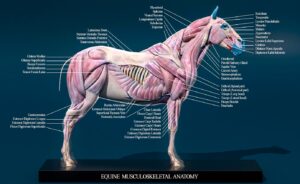Equine Origin and Insertion Massage techniques are a type of massage therapy that targets the points where muscles attach to the skeleton. The origin is the attachment point of a muscle that is typically fixed, while the insertion is the attachment point that moves when the muscle contracts. The origin and insertion points of muscles are areas of high tension and stress, as they are where the muscle experiences the most mechanical strain.
Origin and Insertion techniques involve applying gentle pressure and stretching movements to the origin and insertion points of muscles to help release tension, improve overall muscle function, reduce pain, stiffness, assist in releasing muscle contractures (hypertonicity) and muscle spasms, reduce the risk of injury.
 The Origin and Insertion Massage techniques can be used in a variety of situations, including pre- and post-exercise, as part of a maintenance program, or to address specific muscle imbalances or injuries. This technique essentially tones down the nervous system to release the muscles and also reflexively helps the deeper layers to relax by engaging the Golgi tendon organs (GTO). It is mostly used in the acute or subacute stage of a condition where pressure must be applied lightly due to the sensitivity of the nervous system, pain in general or if you cannot work on the muscle belly. It is very effective in decreasing muscle spasms and on muscles that cross an area of inflammation. It is also very effective for chronic condition.
The Origin and Insertion Massage techniques can be used in a variety of situations, including pre- and post-exercise, as part of a maintenance program, or to address specific muscle imbalances or injuries. This technique essentially tones down the nervous system to release the muscles and also reflexively helps the deeper layers to relax by engaging the Golgi tendon organs (GTO). It is mostly used in the acute or subacute stage of a condition where pressure must be applied lightly due to the sensitivity of the nervous system, pain in general or if you cannot work on the muscle belly. It is very effective in decreasing muscle spasms and on muscles that cross an area of inflammation. It is also very effective for chronic condition.
These techniques may be useful for horses that engage in high levels of physical activity, such as athletes, racehorses, and eventers. It is only contraindicated if all local, general and abdominal massage is contraindicated.
Superficial-Deep-Superficial (SDS) is a fundamental principle of Equine Origin-Insertion Massage techniques because it helps to increase blood flow and promote healing in the muscle tissue. This principle involves applying massage techniques in a specific sequence to target the muscle fibers from the surface layer to the deeper layers and then back to the surface layer.
In Equine Origin-Insertion Massage techniques, the therapist focuses on the attachments of the muscle to the bone, tendon or ligament, as well as the muscle fibers themselves. Massaging around the muscle belly helps to improve circulation and promote relaxation of the muscle fibers, improving their ability to contract and release. This can help to reduce muscle tension and stiffness, and improve range of motion. Working on the musculo-tendinous attachments can help to reduce tension and adhesions that may have formed in these areas, improving the muscle’s ability to transfer force from the muscle to the bone or tendon, reducing the risk of injury.
The Origin-Insertion Technique involves soothing general massage applied slowly and rhythmically, essentially loosening up the belly of the muscle:
- First, warm up the surrounding tissue, do NOT massage over the belly of the affected muscle.
- Then use alternate fingertip or thumb-tip kneadings on both tendon attachments, working parallel fibre direction towards the muscle belly. The strokes should be relatively short; where possible, start right at the periosteum attachment and go along the tendon to where it meets the muscle. Follow this with a longer stroke transverse to the fibre direction, working both attachments.
- Intersperse these strokes with Effleurage around the muscle belly and use gentle petrissage (muscle squeezing, palmar kneading) on the muscle belly.
- End the treatment with Effleurage for drainage and Nerve Strokings, both of which set the tone for the treatment.
- Hydrotherapy can be added, HEAT if no swelling or spasm.
- Cold for spasm NOT released and HEAT after spasm released
- Range of Motion will re-set muscle as well as let you know if spasm return.
Additionally, Cross-fiber friction, Pin and stretch, and Active Release Technique can be applied to both the origin and insertion points of muscles. These techniques can help to improve circulation, reduce pain and stiffness, improve range of motion, promote healing and reduce inflammation.




